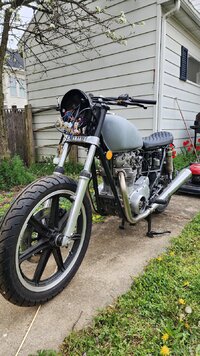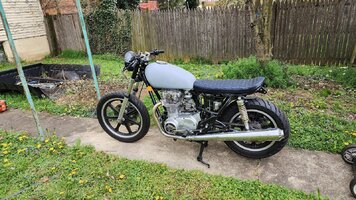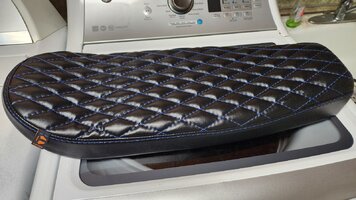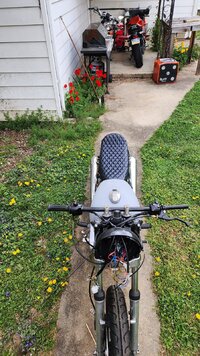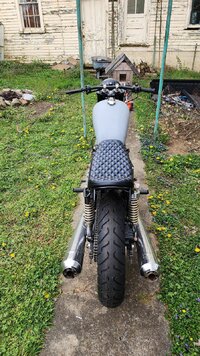Many pleated filters have an internal lip that partially blocks the air passage in the circumference of the carb that feeds the diaphragm chamber. But, ....if/when you get it running be prepared to record timing at 1200 to 1400 rpm. You should have no advance from the factory spec. If you do have advance retard your timing and/or insure your advance mechanism is cleaned and properly lubricated.
-
Enjoy XS650.com? Consider making a donation to help support the site.
XS650.com receives a small share of sales from some links on this page, but direct donations have a much greater impact on keeping this site going.
You are using an out of date browser. It may not display this or other websites correctly.
You should upgrade or use an alternative browser.
You should upgrade or use an alternative browser.
Yam_Tech314's official build thread
- Thread starter G_YamTech_314
- Start date
It's more than that lip on those filters. The simple fact is pleated K&N type pod filters don't work well with CV carbs. They give a turbulent air flow and that messes with the slide lift. This can cause stumbling and break-up, especially in the upper midrange to main transition area. Normally you attribute that to being jetted too rich but it can be the filters causing it.
It's more than that lip on those filters. The simple fact is pleated K&N type pod filters don't work well with CV carbs. They give a turbulent air flow and that messes with the slide lift. This can cause stumbling and break-up, especially in the upper midrange to main transition area. Normally you attribute that to being jetted too rich but it can be the filters causing it.
All of what you guys mentioned is enough for me to get rid of em. As cool as they look I'd much rather have a bike that runs properly. I'll have them ordered later today after I'm done with opening day of some good ole fashioned Pennsylvania trout fishin'.
Hey, G_YamTech,
"The oxen are slow, but the earth is patient"
The only person who should care when you finish is you. Work when you can, at your own pace. The bike isn't going anywhere. But it will go somewhere when you're done, and you'll be proud of it! End of rant...
"The oxen are slow, but the earth is patient"
The only person who should care when you finish is you. Work when you can, at your own pace. The bike isn't going anywhere. But it will go somewhere when you're done, and you'll be proud of it! End of rant...
The UNI filter you want is the UP4200 or UP4200ST (dual layer). The 2" I.D. mounting flange is a perfect slip fit on the BS38 intake bells, they fit like a glove .....

The dual layer ST version isn't really necessary, and it costs a few dollars more. I do have them on my '83 but only because a local guy sold them to me cheap because they wouldn't fit his chopper.
The dual layer ST version isn't really necessary, and it costs a few dollars more. I do have them on my '83 but only because a local guy sold them to me cheap because they wouldn't fit his chopper.
Got me a new tool today! A timing light... My issue must have been more with air/fuel because my timing is pretty close to where it needs to be. Advances properly under throttle too. I'm sure it could all do some fine tuning but it went down the road just fine!
My right cylinder exhaust header gets significantly hotter than. My left. My guess is the left side is a bit cold for some reason. Maybe too rich? You'd think both cylinders would require the same mixture. Perhaps it's a spark issue. I'll figure that out in due time.
I also finally pulled the trigger on a seat for this thing. With so many options and with how important looks are to a build I spent time after time second guessing but finally said "fuggit" and spent the $400... I think it'll look nice once everything is painted.
My right cylinder exhaust header gets significantly hotter than. My left. My guess is the left side is a bit cold for some reason. Maybe too rich? You'd think both cylinders would require the same mixture. Perhaps it's a spark issue. I'll figure that out in due time.
I also finally pulled the trigger on a seat for this thing. With so many options and with how important looks are to a build I spent time after time second guessing but finally said "fuggit" and spent the $400... I think it'll look nice once everything is painted.
Attachments
And if the timing differs drastically then what do I do? With only one plate to adjust I assume my only way of timing adjustment would be to recheck my points gap for each and adjust accordingly?With the dual points, you have to check the timing on each cylinder. It's like having two separate ignition systems, and it's possible for them to differ.
The coils and wires are the ones that came with the bike... I'm going to replace them for good measure... I'm having intermittent spark issues on the left cylinder. It amazes me how well it's running on just one cylinder intermittently. Can't imagine how it feels when it's running on both... It would definitely help me to have a good example of a different properly running xs650 to compare to. Alas. Just gonna have to figure it out! How else do ya learn?
You adjust the plate for the right cylinder. For the left, the points sit on an independently adjustable plate. Set the right first 'cause that moves both sides. Once that's set, adjust the left with it's own mini-plate.And if the timing differs drastically then what do I do? With only one plate to adjust I assume my only way of timing adjustment would be to recheck my points gap for each and adjust accordingly?
The lower set of points is mounted on a separate half plate and can be adjusted on it's own without disturbing the upper set's position and timing. Like Jim said, set the upper points first by rotating the whole backing plate, then set the lower points by only moving the half plate they mount on.
SHEESH. what a difference that made in starting... I swapped to the right side and it was WAY too advanced. Already made my adjustment to get her right in the middle of those two lil marks... That was a huge step in the right direction. Now I'm gonna recheck my left side timing and see how off it really is. Then I'll be able to reliably determine if there's a real misfire going on or if it was just my timing being insanely off... Pretty cool to see that a motor can still run even if the timing is way off.You adjust the plate for the right cylinder. For the left, the points sit on an independently adjustable plate. Set the right first 'cause that moves both sides. Once that's set, adjust the left with it's own mini-plate.
One thing I've always liked about the points is they are, like 5twins pointed out, independent systems. As long as one fires correctly, the bike will run. Needs both to make good power and smoothness, but it'll run on one. That's got me home more than once with a dead cylinder.
I rechecked the left cylinder timing, and it's still just about right. So now both cylinders are timed with engine running and fall within the marks.One thing I've always liked about the points is they are, like 5twins pointed out, independent systems. As long as one fires correctly, the bike will run. Needs both to make good power and smoothness, but it'll run on one. That's got me home more than once with a dead cylinder.
The left pipe still is significantly slower to heat up than the right one. I'm still gonna say there's an ignition issue with that cylinder. Otherwise there's a large difference in fuel mixture between the two. I lean towards ignition because of the lack of change with the plug being pulled... Which begs my next question: what are the best known NEW coils and wires to run? I've done some searching and can't find a definitive answer.
You can swap coils pretty easy. Swap the HT leads on the plugs. Then pull the tank and swap the wires on the coils running down to the points. That'll swap the coils, then see what effect that has on which cyl is hot.
No change would suggest ignition is good and the carb/fuel is suspect. If the dead cyl swaps sides, sumpin's wrong with ignition (on the dead side).
No change would suggest ignition is good and the carb/fuel is suspect. If the dead cyl swaps sides, sumpin's wrong with ignition (on the dead side).
I just took it around the block again... It's got way more power... Pipes are still very different in temp.
146° C on right header directly after cylinder head
93° C on left header in the same spot.
These measurements are according to my AMES multimeter thermocouple attachment... Still though, pretty significant difference.
146° C on right header directly after cylinder head
93° C on left header in the same spot.
These measurements are according to my AMES multimeter thermocouple attachment... Still though, pretty significant difference.
Your plug wires seem long enough, swap the left plug wire through the frame to the right plug. Have the left coil firing the right plug and vice versa. Let's all assume the valves are set correctly..
I have em pretty close but thats my next tool to invest in... A good set of sync gauges. I work on enough old shit to need them. I synced them mechanically by holding the butterfly's wide open and measuring the distance from the edge of the venturi to the edge of the center of the butterfly. I'm sure they could be closer.Are your carbs synced, or at least close to being synced? If not, that can cause a temp difference in the cylinders because one is running slower than the other.
I'm gonna swap coils and see what that does. I'm highly suspect of the ignition system being faulty in some way though because when it's idling and I have my hands covering each exhaust I can feel a pretty hefty pop in the colder cylinder every couple of revolutions. The other cylinder is firing consistently with no variation of pressure.
If swapping coils doesn't do anything I'll be surprised. But if it doesn't then I'll take yet another hard look at my carb set up and wait til I get proper uni 4200's and a decent gauge set.
I synced them mechanically by holding the butterfly's wide open and measuring the distance from the edge of the venturi to the edge of the center of the butterfly. I'm sure they could be closer.
You want to sync the butterflies with 'em closed. The carbs spend most of their lives down in that range. I also suspect the sync is causing (a lot of) your problems. Sync 'em so both just start to open at the same time. See what that does.
If you think about it, if it's popping, the plug is firing. Get the sync sorted, then see where you're at.
Similar threads
- Replies
- 214
- Views
- 26K
- Replies
- 98
- Views
- 8K

